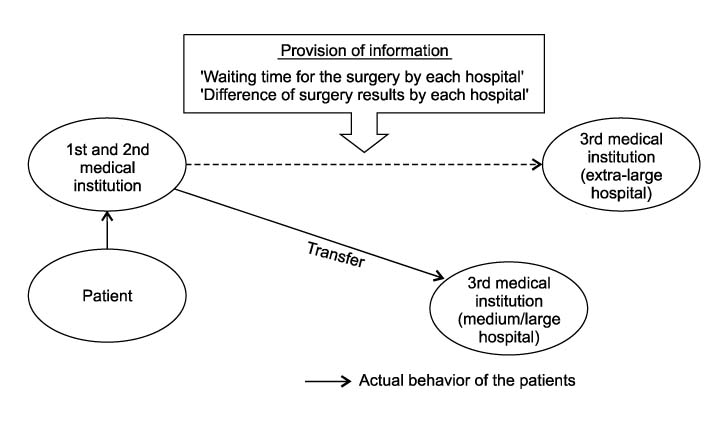J Korean Surg Soc.
2011 Jun;80(6):373-383. 10.4174/jkss.2011.80.6.373.
The effective distribution system for the concentration of patients to extra-large hospitals
- Affiliations
-
- 1Department of Service Systems Management & Engineering, Sogang University Graduate School of Business, Seoul, Korea. jaekisong@sogang.ac.kr
- 2Area of Information Systems and Quantitative Sciences, Texas Tech University Rawls College of Business, Lubbock, TX, USA.
- KMID: 2212181
- DOI: http://doi.org/10.4174/jkss.2011.80.6.373
Abstract
- PURPOSE
In Korean society, extra-large hospitals are congested with the majority of patients. Because of the congestions, the urgent patients need to wait anywhere from as short as a month to around three months. These concentrations of the patients on the extra-large hospitals causes not only the economic problem in terms of loss of opportunity cost and resources of other medium and large hospitals but also the fear and the consequential stress of the patients and the families of the patients who are waiting for the surgeries. The phenomenon of the concentrations derived due to the insufficient information to the medical consumers. If the information on medical treatment services such as surgery schedule is provided before the selection of hospital, we expect that the selection of hospital for the patients and their family will differ, resulting in redistribution of concentration phenomenon. In this paper, we propose and verify the effective distribution system for the concentration on the extra-large hospitals.
METHODS
Web simulation survey was conducted. A total 100 respondents were divided into 4 groups of 25 respondents and the different information was provided to each group.
RESULTS
Through multiple comparisons among groups, only group which was provided with both information about 'the difference of surgical results' and 'the waiting time for surgery', had difference in significance.
CONCLUSION
By providing two sets of information to patients, reckless selection of extra-large hospitals can be spread to more appropriate hospitals and therefore achieve effective distribution of the population concentration on extra-large hospital.
Keyword
MeSH Terms
Figure
Cited by 2 articles
-
The survival impact of surgical waiting time in patients with resectable pancreatic head cancer
Hye Kyoung Seo, Dae Wook Hwang, Seo Young Park, Yejong Park, Seung Jae Lee, Jae Hoon Lee, Ki Byung Song, Young-Joo Lee, Song Cheol Kim
Ann Hepatobiliary Pancreat Surg. 2018;22(4):405-411. doi: 10.14701/ahbps.2018.22.4.405.A nationwide study of regional preference and graft survival of kidney transplantation in South Korea: patterns of centralization in the capital area
Jeong-Ik Park, Youngjin Jang, Hojong Park, Sungchoul Pyun, Hong Rae Cho, Sang Jun Park
Ann Surg Treat Res. 2024;106(1):11-18. doi: 10.4174/astr.2024.106.1.11.
Reference
-
1. Lee YK. Factors influencing over outpatients' choice of tertiary general hospital [dissertation]. 2003. Seoul: Seoul National University.2. Kim EH, Yu SY. The hospital selection study according to the hospital characteristic of the medical consumer: focus on medical advertising implication. Korean J Consum Advert Psychol. 2009. 10:401–417.3. Shin SM, Lee EN, Kang JY. Uncertainty, medical staff's support, and anxiety perceived by family members with patients undergoing surgery for cancer. J Korean Oncol Nurs. 2006. 6:15–26.4. Leske JS. Intraoperative progress reports decrease family members' anxiety. AORN J. 1996. 64:424–425. 428–436.5. Carmody S, Hickey P, Bookbinder M. Perioperative needs of families: results of a survey. AORN J. 1991. 54:561–567.6. Donnell SG. Coping during the wait. Surgical nurse liaison program aids families. AORN J. 1989. 50:10881090–1092.7. Mulgan R, Logan RL. The coronary bypass waiting list: a social evaluation. N Z Med J. 1990. 103:371–372.8. Sung KW. A study on the emotional anxiety of fathers of pediatric cancer patient [dissertation]. 2001. Seoul: Ewha Womans University.9. Petty RE, Wegener DT. Chaiken S, Trope Y, editors. The elaboration likelihood model: current status and controversies. Dual-process theories in social psychology. 1999. New York: Guilford Press;41–72.10. Petty RE, Cacioppo JT. Communication and persuasion: central and peripheral routes to attitude change. 1986. New York: Springer-Verlag.
- Full Text Links
- Actions
-
Cited
- CITED
-
- Close
- Share
- Similar articles
-
- The Effect of Having Usual Source of Care on the Choice among Different Types of Medical Facilities
- Evaluation of Carcinoembryonic Antigen and Alpha-Fetoprotein in Neurologic Lesions
- Standardization of Code of Hospital Information
- Polarization of cancer patient management
- Antibiotic Concentrations of Cerebrospinal fluid in Patients with Various Amount of Extraventricular Drainage during Intraventricular Infusion



